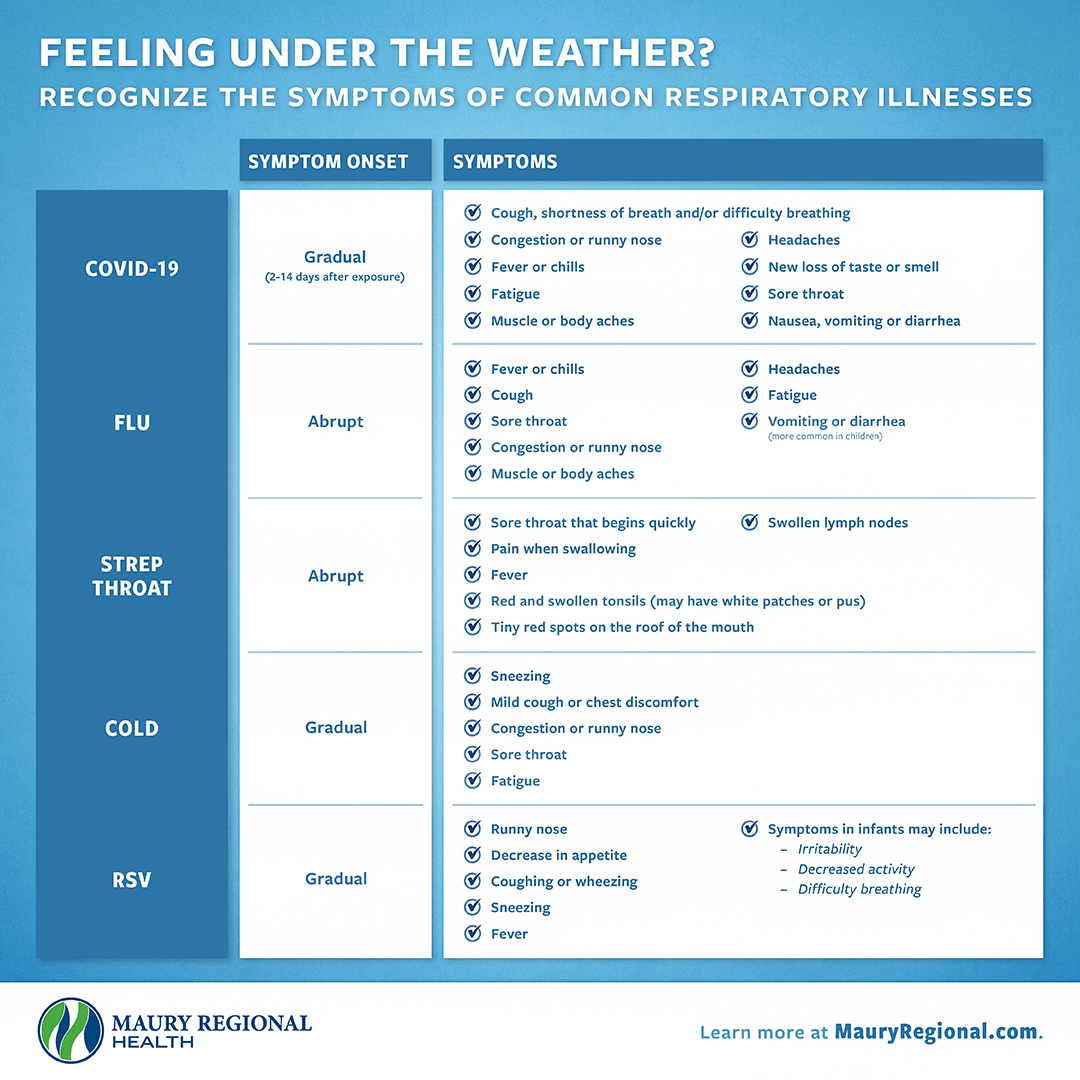
Feeling under the weather?
Recognize the symptoms of common respiratory illnesses
We must all continue to remain diligent in our efforts to slow the spread of COVID-19. It is also important to recognize the symptoms of other common respiratory illnesses like flu, strep, RSV and the common cold.
COVID-19
Symptoms of COVID-19 can range from mild to severe and vary by individual. Symptoms may appear 2-14 days after initial exposure to the virus and include one or more of the following:
- New loss of taste or smell (often an early indicator of COVID-19 infection)
- Cough, shortness of breath or difficulty breathing
- Congestion or runny nose
- Fever or chills
- Fatigue
- Muscle or body aches
- Headaches
- Sore throat
- Nausea, vomiting or diarrhea
Vaccination is available to help protect against COVID-19, including severe illness that can lead to hospitalization and death. Learn more about vaccination as well as testing, treatment and other information related to COVID-19 here.
Influenza
Influenza - commonly known as flu - can occur at any time of year, but is most common between October and May in the U.S. Flu symptoms typically develop quickly and include:
- Fever or chills (though not everyone with the flu will have a fever)
- Cough
- Sore throat
- Congestion or runny nose
- Muscle or body aches
- Headaches
- Fatigue
- Vomiting or diarrhea (though this is more common in children than adults)
According to the CDC, people with flu are most contagious 3-4 days before their illness begins and up to 5-7 days after becoming sick. Like COVID-19, the flu is spread via airborne droplets from the mouth or nose when someone talks, coughs or sneezes.
If a patient tests positive for the flu, prescription anti-viral medications may be used to treat the illness if administered early in the infection. These medications cannot be acquired over-the-counter. If you believe you may have the flu, call your primary care provider or visit your closest urgent care.
Vaccination is the best defense against the flu. The CDC and Maury Regional Health clinicians recommend everyone age six months and older get a flu vaccine before November 1, unless otherwise directed by their physician.
Learn more at CDC.gov/flu.
STREP
Strep is a highly contagious bacterial infection in the throat and tonsils with symptoms that include:
- A sore throat that begins quickly
- Pain when swallowing
- Fever
- Red or swollen tonsils that may also have white patches or pus
- Tiny red spots on the roof of the mouth
- Swollen lymph nodes
People of all ages can contract strep year-round, but it is most common among children (ages 5-15) during winter and spring. Like COVID-19 and the flu, strep is quickly spread via airborne droplets.
Prescription antibiotics are used to treat strep if the patient receives a positive strep test, which is performed during an in-person visit with a medical professional. Without antibiotics, strep can lead to more serious infections developing in the tonsils, sinuses, skin, blood or middle ear. If you believe you may have strep, call your primary care provider to schedule an appointment or visit your closest urgent care.
Learn more at CDC.gov.
COMMON COLD
The common cold is a respiratory illness that typically occurs in the winter and spring that consists of:
- Sore throat
- Runny nose
- Coughing
- Sneezing
- Headaches
- Body aches
There is no cure for the common cold, but health experts recommend getting plenty of rest and drinking lots of fluids. Antibiotics should not be used to treat a cold. Click here for more information about the dangers of antibiotic resistance.
RSV
Respiratory syncytial virus, or RSV, is a respiratory virus that typically causes mild, cold-like symptoms. While many of those with RSV recover in 1-2 weeks, the virus can have a serious effect on some people, including infants and older adults — potentially leading to bronchitis, pneumonia and other respiratory illnesses that may require hospitalization.
Symptoms typically appear 4-6 days after initial exposure and develop gradually rather than all at once. These symptoms often include:
- Runny nose
- Decrease in appetite
- Coughing
- Sneezing
- Fever
- Wheezing
Young infants may only exhibit the following symptoms: irritability, decreased activity and breathing difficulties. According to the CDC, RSV is so common that nearly all children will have had an RSV infection by their second birthday.
Most mild RSV infections will go away within 1-2 weeks by getting plenty of rest, drinking lots of fluids and taking an over-the-counter fever reducer (talk to your pediatrician first before giving nonprescription cold medicines to your child). However, if the individual is having difficulty breathing or showing signs of dehydration, it is important to see a doctor quickly. Depending on the severity, they may require hospitalization.
Learn more at CDC.gov.
SEASONAL ALLERGIES
According to the CDC, seasonal allergies are triggered by airborne pollen that affects the nose, sinuses and eyes. Symptoms can vary from person to person, as well as based on geographic region and allergy variants, but primarily include:
- Congestion or runny nose
- Watery, itchy or red eyes
- Sneezing and coughing
- Fatigue
- Itchy nose, roof of mouth or throat
There is no medical treatment for allergies, but you can take preventive action by limiting your time outdoors, seeking indoor spaces with clean air and taking prescription or over-the-counter allergy medication as recommended by your primary care provider.
Learn more at CDC.gov.
